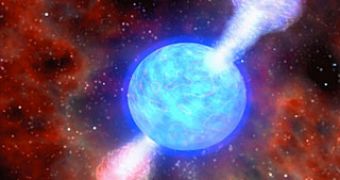Gamma-ray bursts are the brightest and most powerful type of electromagnetic radiation that can be emitted in the universe in the outcome of a violent stellar explosion, whose afterglow remains extremely bright up to several hours after the occurrence of the event that generated it. A new study found that afterglows determined by short gamma-ray bursts are in fact brighter than typical ones.
According to current models, gamma-ray bursts are emitted during violent events - such as the gravitational collapse of a dead star into a black hole or a neutron star interacting with a cloud of matter, in the process creating energetic jets traveling at relativistic speeds and originating from its poles. Any matter interacting with the gamma-ray burst is in turn energized and forced to glow brightly up to several hours after the event.
Most of the time, long bursts are associated with the supernova explosion of a massive star, while shorter ones are most likely determined by the merging of two neutron stars, for example, since around them there would be little matter that could be energized and determined to glow brightly afterwards.
However, scientists of the Space Telescope Science Institute found that the energy and brightness of a short gamma-ray burst compared to its afterglow several hours later are roughly the same. "We didn't expect that at all," said astronomer Melissa Nysewander, former member of the Space Telescope Science Institute and co-author of the research.
Although the results appear surprising, in the end they may point out towards a single cause: astronomers were wrong about the progenitors of short gamma-ray bursts. Others, however, believe that it's the afterglow models that are flawed, not the progenitors.
Chris Fryer of the Los Alamos National Laboratory, for example, proposed a model in which plasma accounts for less of the energy of the relativistic jets, while the magnetic fields created by the shock waves take up most of the energy of the jets. This way, electrons caught in the powerful magnetic field are accelerated and determined to create bright emissions similar to those observed in the case of short bursts.
Similar processes may be responsible for the outbursts emitted by supermassive black holes inside active galactic nuclei. "As we get more and more detailed data the simple model is breaking down," Fryer says while pointing out that the previous model applied relatively well even when the data was not completely processed.

 14 DAY TRIAL //
14 DAY TRIAL //